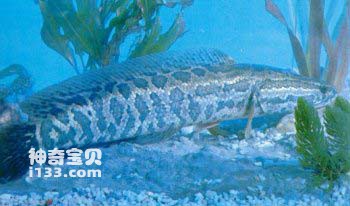Snakehead is a carnivorous and ferocious fish. Like the snakehead, it feeds on fish, shrimp, etc. But its hunting method is different from that of the anchovy, and it never actively chases its prey. Snakehead often lurk in shallow water areas with turbid water and overgrown aquatic plants. If the water is clear and the water flow is slow or calm, they will often hide under the aquatic plants or in the still water layer. When catching food, it never relies on its strong body and fast swimming ability to chase small fish, but instead uses cunning means to achieve the purpose of chasing food. When it finds a small fish, it hides in the nearby aquatic plants and peeps quietly, waiting for the other party to relax its vigilance and swim near it. Then it suddenly rushes forward, bites the small fish in one fell swoop and devours it in a sudden attack.

Gars that live in North American rivers are more cunning in their hunting methods. When it discovers a school of small fish, it first swims toward the school of fish quietly, its whole body like a piece of driftwood, concentrating on the prey. When its long snout reaches the appropriate position away from the small fish, it uses its head to move sharply, fiercely and convulsively. Sweep across. First bite the prey, then slowly adjust the small fish in the mouth to a suitable position for swallowing, and finally swallow the small fish.
The parent fish of snakehead has the habit of protecting its young. Whenever the breeding season comes, the male and female broodstock will choose the spawning location in swamps, lakes, bottoms, banks among aquatic plants in rivers, or shallow water beaches with reeds. Before spawning, male and female parent fish jointly pick up aquatic plants or plant fragments to build fish nests. The size of the nest depends on its individual size. The nest is slightly ring-shaped and the eggs are laid in the nest. After spawning, a pair of parent fish or only the male fish lurks in the fish nest or guards the eggs near the nest to prevent other fish or frogs from getting close to avoid harm. The yolk sac of the newly hatched larvae significantly enlarges the front part of the body, and the larvae lie on their sides and float gently on the water surface, while the parent fish guard the bottom of the larvae. As the larvae develop, the yolk sac disappears and the young fish can swim vertically, but only near the fish nest.
At this time, the defensive activities of the parent fish become more intense. If there are other fish or frogs trying to attack the seedlings, the parent fish will go all out to drive them away. When the seedlings grow to 10-30 mm, their mobility will be strengthened, their movements will be lively, and their range of activities will also be expanded. As the fish expands, the parent fish and juvenile fish gather together and shuttle around the fry for enhanced protection. When the seedlings reach 40-50 mm, the body color of the fish changes from yellow-green to dark green, fins appear on each fin, and it has strong swimming ability. At this time, the young fish begin to disperse and live independently, and the male and female parent fish will end at this time. It spends its annual life as a nurse, leaving the fish nest and looking for its own habitat.
animal tags:
We created this article in conjunction with AI technology, then made sure it was fact-checked and edited by a Animals Top editor.